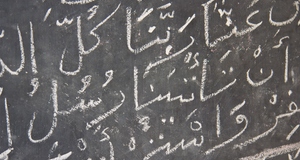Featured Article:Linguistic Essentialism and Indigenous Authenticity: The Role of Indigenous Languages in Defining Indigeneity
By
2020, Vol. 12 No. 09 | pg. 1/1
IN THIS ARTICLE
Since the European invasion of Latin America in the sixteenth century, the concept of indigeneity has been inherently political. In what can only be described as an ongoing ethnocide, colonial powers did everything they could to stomp out the rich diversity of indigenous cultures throughout the land while imposing their Western Christian values upon colonized groups. After centuries of being denied their own culture, indigenous groups now struggle to preserve their surviving cultural practices. One such element of culture that many indigenous peoples see as tied directly to their identities is language. While it must be noted that language is not the sole defining characteristic of any given culture, it is a critical tool in understanding individuals as agents within their cultural contexts, because of its capacity to index parts of a given speaker’s identity, including class, race, and age. This essay examines the role that language plays in various indigenous peoples’ construction and negotiation of their identities and how it functions as a political tool in certain contexts. I also demonstrate the political function of language in indigenous peoples’ self-presentation to outsiders, as well as the role of language in cultural reinforcement within communities. From De-Indianization to Cultural RecoverySo much of precolonial Mesoamerican culture was violently dismantled and disposed of through the colonial practice of de-Indianization. Guillermo Bonfil Batalla defines this concept as “a historical process through which populations that originally possessed a particular and distinctive identity….are forced to renounce that identity, with all the consequent changes in their social organization and culture” (Batalla 1996:17). The continuous and pervasive nature of de-Indianization ensured that the rich cultural diversity that once characterized Mesoamerica was gradually but permanently erased over centuries of cultural domination. While some aspects of indigenous culture remain in the mainstream, commonly serving as the dominant culture’s claim to diversity, these representations are mere commodifications of the “diverse ethnic mosaic” (ibid. 19) of Mesoamerican culture. Some indigenous groups were able to retain parts of their traditional cultures; others became so far removed from their origins through these processes of European cultural domination that they hardly consider themselves indigenous. Therefore, the maintenance of traditional indigenous culture has been a common struggle throughout postcolonial Latin American history, and thus, successful cultural preservation can be understood as an act of resistance against a long-term ethnocide. While indigenous identity politics have been present throughout Latin American history, it was not until the 1980s and 1990s that national and international law began to recognize indigenous peoples as marginalized affinity groups deserving of cultural protection and representation. As neoliberal ideology began to permeate the international sphere, Latin American governments followed suit by reversing their push for indigenous assimilation, instead encouraging and sanctioning indigenous cultural recovery. The resulting policy changes introduced new dynamics between state actors and indigenous communities, and clearly defined indigenous communities as their own nations – “each with rights to autonomy, respect for its cultural identity and language, and protection of its territories” (Crabtree 2017:58). In order to receive political recognition and land rights, however, indigenous communities had to meet state governments’ definitions of ‘authentic’ indigenous status. This definition of authenticity emphasized cultural purity and continuity, which presented a deep contradiction: the very aspects that marked indigenous peoples as inferior to the dominant Spanish culture for hundreds of years were now the very characteristics they were required to possess in order to receive the rights and resources which they sought. The most important of these markers of indigeneity in the eyes of the state was fluency in an indigenous language – an uncommon feature of many communities due to hundreds of years of being denied the rights to even use these languages instead of the dominant Spanish. However, indigenous communities have begun to employ their own discourses and boundary-marking linguistic practices that serve to criticize, uphold, manipulate, or respond to their national governments’ prescriptive notions of what authentic indigenous culture looks like. The two principal functions of these practices that I will examine are performing indigeneity for the state, and reinforcing and defining identity within their own communities.Essentialist ThinkingLatin American national governments’ understandings of culture and language assume a clean, direct link between the two. This notion is rooted in the logic of linguistic essentialism, also known as ethnolinguistic linking; defined as “the identification of a language with a people and a consequent diagnosis of peoplehood by the criterion of language” (Woolard 1998:16). Ethnolinguistic linking was historically employed in elite Western European discourses surrounding the division of colonized territories; colonial powers often used language as the defining boundary between groups of people and as the sole determinant of ethnicity. These colonial understandings of languages having ‘natural’ boundaries that situated them as fundamentally separate from one another neglected to recognize the multiplicity of distinct ethnic groups or cultures that may exist within a larger geographical region. As such, multiple languages of colonized people would often be lumped into one category; the single category of the language thus supposed a single, homogeneous ethnic group. Having established this false equivalence between language and ethnicity, it follows that “the absence of a distinct language can cast doubt on the legitimacy of claims to nationhood” (Woolard and Schieffelin 1994:60); thus formed the basis for the oversimplified definition of indigeneity by Latin American state governments. Such thinking can be dangerous in that it actively erases the historical factors that led to the formation and geographical spread of new languages over time. In the following few sections, I will discuss how various indigenous peoples reject these essentialist notions in their use of language, or conversely, how they employ them strategically to gain political agency. Swear Words and Indigenous Identity in CucapáThe indigenous community of the Cucapá in El Mayor, Mexico is one such group that has had to navigate the complex relationship between language and identity in reaction to the prescriptive definition of indigenousness by their national government. Linguistic anthropologist Shaylih Muehlmann observed over twelve months of ethnographic research in El Mayor how Cucapá youth “critically engage with the assumption that their identity is located in their fluency in the Cucapá language” (2008: 34) using boundary marking practices and subversive parody of authority. Unsurprisingly, many young people do so through the use of swear words, or groserías. From a sociolinguistic perspective, swear words can serve as powerful in-group markers, often with an added dimension of socioeconomic class; Muehlmann states that in such contexts, the association of swear words with crudeness and negativity is “converted into positive attributes when the words are used between members of a community practice” (ibid. 37). What is notable about the Cucapá’s use of swear words is that, although their language has largely faded into obsolescence and replaced with Spanish, groserías are always said in Cucapá. Muhlemann demonstrates one of the powerful subversive functions of Cucapá groserías with anecdotes she collected from the Cucapá during her research. One research subject described the following scenario: “Sometimes you go out in the sierra or in the desert and the soldiers are there and they won’t let you pass. They stop you, pointing their guns at you on your own land and they ask you your business. At times like this the chamacos [kids] simply say ‘Soy Indiano’ in Spanish and then in Cucapá they say ‘go screw yourself!’ to which the soldiers say ‘oh,’ ‘pásale’ (go ahead)” (ibid. 39). This scenario places the Cucapá children in the position of having to ‘prove’ the authenticity of their indigeneity in order to justify their presence on the land. In doing so, they must perform their ‘Indian-ness’ to outsiders. By using a grosería as proof of one’s indigenous language fluency to an unsuspecting nonmember who does not speak the language, Cucapá children are fulfilling the request to prove their identity to an outsider authenticator, while simultaneously practicing a clever subversion and parody of authority. The irony of this interaction is that “[b]y reversing roles, subverting their authenticators, and subjecting the outsiders to the very authenticating measures so often used against them” (ibid. 41), they are employing the Cucapá language as a vehicle of subtle resistance against the notion that indigeneity can be defined by outsiders. Cucapá use of swear words sits in contrast to certain paternalistic Western academic interpretations of indigenous peoples’ use of obscenities within a larger dominant culture. Such stereotypes employ conflicting notions of the ‘noble savage,’ too naive to understand the weight of the vulgarities he utters, and conversely, the drug addict whose violent tendencies are reflected in his use of crude language. However, these views are refuted by Muehlmann’s contention that swear words can serve a critical function in the presentation of identity to outsiders, and that in this case, swearing is “less about engaging in the sociality of the obscene than about negotiating claims to indigeneity” (ibid. 43). Zápara Performativity as a Political ToolWhile some indigenous groups use their language as a means of subverting outside definitions of authenticity, others systematically employ it as a means to strategically conform to such definitions for political advancement. The Zápara people of Ecuador are one of the smallest indigenous populations in the Amazon, and as such, rely heavily on identity politics to create political representation for themselves in a larger national context. Zápara leaders, or dirigentes, often perform their indigeneity to outsiders in order to indicate their legitimacy and therefore their right to voice their political demands. Anthropologists have observed how many dirigentes employ an overly performative sort of indigeneity that often conforms to Western notions of Indianness – for instance, using traditional headdresses and body paint to underscore their exoticism to outside observers. Many of these tactics also adhere to a narrative of cultural “purity,” and in doing so, undermine the historical reality of cultural hybridity amongst indigenous groups in the Amazon. In postcolonial Amazonia, the Zápara people, once numerous and thriving, suffered disease, enslavement, and land disenfranchisement at the hands of Spanish colonists. The forced relocation of the Zápara led to their being integrated into neighboring tribes, prompting a “process of ethnogenesis in which Quijos, Zápara, and Achuar intermarried” (Viatori 2007:109). As a result, many of these hybrid cultures were multilingual, and adopted the Kichwa language as the lingua franca. By the twentieth century, most Zápara spoke Kichwa, and the Zápara language was nearly extinct. This narrative, however, is inconsistent with Zápara dirigentes’ presentation of their people as culturally pure. While by linguistic essentialist standards, the widespread use of the ancient indigenous language Kichwa is enough to deem the Zápara ‘authentically’ indigenous, it is not unique to the Zápara and therefore “does not function as an effective symbol for Zápara identity” (ibid. 110). Thus, in order to establish themselves as a unique nationality with political interests specific to them, Zápara dirigentes downplay the use of Spanish and Kichwa in their communities to outside observers and instead portray the Zápara language as directly linked to their political identities, goals, and history. In this sense, these dirigentes serve as arbiters of cultural and political capital, but in the process, “invalidate specific historic and contemporary expressions of hybridity in Zápara practices that do not fit within essentialist constructions of indigenousness” (ibid. 106). Indexing Maya Identity through LanguageSo far, I have discussed indigenous subversion of authority and power-marked language dynamics in response to linguistic essentialist definitions of indigenous authenticity, as well as how indigenous groups may strategically employ such discourses themselves for their own political advancement. Here, I will discuss another interaction amongst indigenous groups, language, and culture by examining how class, ethnic, and territorial identities are indexed through a process which Walter Mignolo calls “languaging” (Mignolo 2000:226), in which a speaker’s linguistic performance moves between various forms. Drawing inspiration from Guillermo Bonfil Batalla’s conceptualization of the conflicting worlds of the “imaginary Mexico” and the “Mexico profundo” (Batalla 1996:xv), Fernando Armstrong-Fumero examines two local styles of the Yucatec Maya language which he terms “Imaginary Maya” and “Deep Maya” (Armstrong-Fuero 2009:362). Imaginary Maya, or “good” Maya, refers to a simplified understanding of the Maya language as linguistically pure and functionally homologous with Spanish; it also connotes an idealistic, uniform Maya identity. Deep Maya, in contrast, employs “practices such as punning and code switching to exploit a range of phonological ambiguities that exist at the interstices of Spanish and Maya” (ibid.), and in doing so, indexes an individual speaker’s distinctive identity by diverging from the traditionally European ‘pure’ notion of the language. The social positioning of Deep Maya is further indexed by its added dimension of class in that it is largely associated with rural farming communities. Historically, the Imaginary Maya language grew out of the European introduction of alphabetic writing to transcribe Mesoamerican languages in the sixteenth century, which in turn led to the imposition of prescriptive notions of grammatical purity upon the Maya language. These ideas of what language ‘should’ be were permeated by Western romanticist ideals that assumed hierarchies between the civilized and primitive, and “posited unified forms of speech as a fundamental element of the consolidation of strong and enlightened nation-states” (ibid. 364). The manufactured discrepancy between a linguistically ‘pure’ Maya language and its practical, fluid, spoken form created the circumstances by which Deep Maya became not only a language, but a weaponized form of identity; Deep Maya often employs satire and punnery of these more historically ‘elite’ language forms (principally Spanish) in order to invert these historical language hierarchies and position the dominant Spanish culture and language as the butt of a joke. In doing so, Deep Maya allows its speakers to actively refute imposed Western notions of language and identity, and to establish and communicate their cultural authenticity. This process of ‘languaging’ constitutes a significant understanding of localized formations and understandings of Maya identity as both a form of resistance and cultural self-definition. Language plays a critical role in the construction and maintenance of social hierarchies. Particularly in colonized territories, the language an individual speaks in is indicative of hundreds of years of historical culture domination (or cultural resistance to it). The shift to neoliberal ways of thinking in Latin America emphasized individuality and multiculturalism, but instead of providing resources with which indigenous peoples could cultivate these things, state governments merely reversed the direction of the suppression of indigenous identity. For hundreds of years, the goal was assimilation and erasure of indigenous peoples; being too indigenous was thus undesirable. In recent decades, we have seen how the new cultural hierarchy now threatens those who may not be perceived as indigenous enough, ignoring the role of state governments in systematically destroying these cultures. Despite this, indigenous peoples have found creative ways to negotiate their identities in light of these prescriptive notions. We have observed how the Spanish-speaking Cucapá use obscenities in the traditional Cucapá language to subvert assumptions about and power dynamics surrounding indigenous languages; we have seen how the Zápata people controversially employ and manipulate mainstream conceptualizations of indigeneity to receive political and social recognition as a unique culture; and we have seen the divergence of the Maya language into an idealized, European-bred linguistic stereotype, and a richer and multifaceted language that carries with it historical meanings of Maya identity. Thus, we have seen the many ways in which language can be used not only as a form of resistance against dominant powers, but also as an indexer of identity within a hierarchical postcolonial framework. ReferencesArmstrong-Fuero, Fernando. 2009. “Old Jokes and New Multiculturalisms: Continuity and Change in Vernacular Discourse on the Yucatec Maya Language.” American Anthropologist. 111(3):360-372. Batalla, Guillermo Bonfil. 1996. Mexico Profundo: Reclaiming A Civilization. Austin: University of Texas Press. Crabtree, John. 2017. “Indigenous Empowerment in Evo Morales’s Bolivia.” Current History. February 2017: 55-60. Mignolo, Walter. 2000. Local Histories/Global Designs: Coloniality, Subaltern Knowledges, and Border Thinking. Princeton: Princeton University Press. Muehlmann, Shaylih. 2008. “‘Spread Your Ass Cheeks’: And Other Things That Should Not Be Said in Indigenous Languages.” American Ethnologist. 35(1):34–48. Viatori, Maximilian. 2007. “Zápara Leaders and Identity Construction in Ecuador: The Complexities of Indigenous Self-Representation.” Journal of Latin American and Caribbean Anthropology. 12(1):104-133. Woolard, Kathryn A., 1998. Introduction: language ideology as a field of inquiry. In: Schieffelin, Bambi B., Woolard, Kathryn A., Kroskrity, Paul V. (Eds.), Language Ideologies: Practice and Theory. Oxford University Press, New York, pp. 3–47. Woolard, Kathryn A., Schieffelin, Bambi B., 1994. Language ideology. Annual Review of Anthropology 23, 55–82. Suggested Reading from Inquiries Journal
Inquiries Journal provides undergraduate and graduate students around the world a platform for the wide dissemination of academic work over a range of core disciplines. Representing the work of students from hundreds of institutions around the globe, Inquiries Journal's large database of academic articles is completely free. Learn more | Blog | Submit Latest in Anthropology |


















